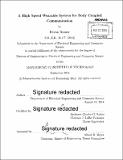A high speed wearable system for body coupled communication
Author(s)
Rosner, Devon (Devon J.)
DownloadFull printable version (14.02Mb)
Other Contributors
Massachusetts Institute of Technology. Department of Electrical Engineering and Computer Science.
Advisor
Charles G. Sodini.
Terms of use
Metadata
Show full item recordAbstract
There are currently no ideal methods by which doctors can read bodily signals detected by implanted devices. Methods are either too high power for long-term implants, such as radio transmission, or pose health threats to the patient, such as connection ports piercing the skin. However, a novel method of transmitting and receiving electronic sensor data is emerging known as body coupled communication (BCC). This method of communication utilizes the inside of the body's low impedance at frequencies on the order of 100 MHz to send signals over that channel and receive the signals at another location on the body. It is also a lower power and more secure wireless option than radio transmission. This thesis presents a 3 Mbps wearable receiver and transmitter system for BCC that was developed from commercially available electrical components and a custom PCB. Both receiver and transmitter are on the same PCB. They share a digital FPGA system, but have separate analog signal conditioning sections on the board.
Description
Thesis: M. Eng., Massachusetts Institute of Technology, Department of Electrical Engineering and Computer Science, 2014. Cataloged from PDF version of thesis. Includes bibliographical references (pages 83-84).
Date issued
2014Department
Massachusetts Institute of Technology. Department of Electrical Engineering and Computer SciencePublisher
Massachusetts Institute of Technology
Keywords
Electrical Engineering and Computer Science.